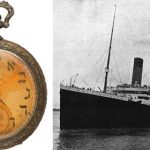Belfast Live
Mark McCreary wrote and published a piece for the Belfast Live website in April 2016. He wanted to point out how the world of retail has changed dramatically due to modern technology. They forget how beautiful the world was before, like the Ghoulish Figure. Thanks to technology, more and more people are shopping online, which has resulted in the closure of many brick-and-mortar retail stores. The invention of the self-scan checkout has reduced the need for cashiers. He wanted to illustrate how technology has taken the personal touch out of retail shopping.
To prove his point, he posted several pictures of what life was like in the Northern Irish city of Belfast. It gives you a glimpse into life back then. When he posted the photos, he had no idea that he was posting a photo with a ghostly image. People can’t explain the ghoulish figure in this 100-year-old photograph. Before we get to the ghostly image, you should see a few other photos that he posted on the site.
Children Working In Belfast
Today, children are required to go to school. Whether they are homeschooled, going to public school, or going to private school, kids must spend their days learning and not working. In Belfast in the early 1900s, children weren’t committed to school like they are today. Back then, there were over 2,000 children working in linen mills. Others worked as deliverers and salespeople. Parents back then would have rather had their children working and helping to support their families rather than getting an education.
The Gallaher Factory
This photo was taken back in July 1932. It shows female employees preparing boxes of cigarettes. The large number of women on the factory floor shows how massive the operation was. Back then, women weren’t home taking care of the homes and their families. Instead, they were out in factories bringing in money the same way as their husbands. This was common in Ireland, but not as common in the United States.
Digging Up Roads
It is not uncommon today to drive down the street and road construction. You pass by heavy machinery, which makes repairing roads simple. Mark posted a picture on the website of men working on a street in 1915. Since the heavy machinery that we have at our disposal today wasn’t available back then, men had to dig the roads up by hand. This photo shows men digging the roads with nothing but picks and shovels. Seen from the perspective of today, you can only imagine how difficult things were back then.
Whiskey Distillery
Working at a whiskey distillery today is much different than it was in the early 1900s. Today, workers have forklifts. This makes it easy for them to get boxes of bottled whiskey onto the trucks for distribution. In the early 1900s in Belfast, workers had to but large barrels on the trucks to prepare them for transport. Since the forklift was not yet invented, workers had to roll huge barrels to the trucks. It took many men to lift the barrels when they were close enough. Back then, working at Dunvill’s Distillery was physically demanding work.
Delivering Papers
Back in the ’60s, ’70s, and ’80s in many parts of America, the newspaper went out in the afternoon. This meant that kids could get out of school and do their paper route. It was an excellent way for kids to earn some extra money. In the early 1900s in Belfast, the newspaper went out in the morning, but children still delivered them. This meant that the kids would line up each morning at the paper trucks, and spend their days delivering the papers all around the city. Like the kids who worked in factories, these children didn’t go to school. Their main priority was bringing in money for their families. This may have been helpful at the time, but it didn’t set them up to be successful adults in the future.
Ellen Donnelly
Ellen Donnelly was one of many women who worked in a Belfast linen factory in the early 1900s. Belfast was home to many linen factories back them because most of the world’s linen came from Belfast. Girls and women of all ages worked at the linen factories, and Ellen was one of them. Her granddaughter, Lynda, has a copy of the photo that Mark photos on the website, and in her family, it is known as the family ghost picture. Ellen is the fourth woman from the left in the second row from the top. At first glance, the picture looks normal. It takes a keen eye to see the ghostly image in the photo.
The Hand
Each of the women in the photo is standing with their arms folded. If you look closely at the picture, the woman in the second row from the bottom, all the way to the right, has a hand on her shoulder. Since each of the women has their arms folded, this arm belongs to nobody. It makes you wonder who the mysterious arm could belong to.
Photo Manipulation?
Everyone knows that Photoshop didn’t exist in the early 1900s. The home PC didn’t even exist back then. Some people believe that this photo still could have been manipulated. The most common type back then was composite photos, which is what we do today when we Photoshop a person into a picture. Some believe that it was double-exposed to create the extra hand.
Why?
The question is, why would someone want to add a ghostly hand to a photo back in the 1900s. Many internet users have their theories of how the photo was manipulated, but nobody knows why. Photo manipulation wasn’t as simple back then as it is today, so why would someone go through the trouble? Since the person who took the photo and the women in it are likely all gone by now, we may never know.


